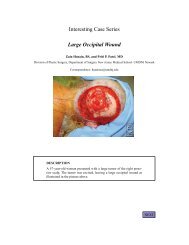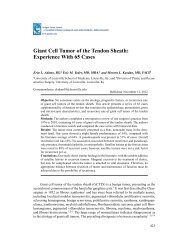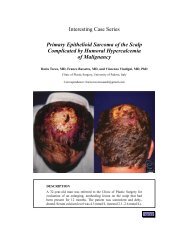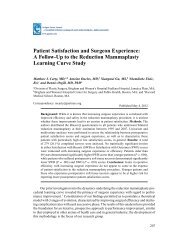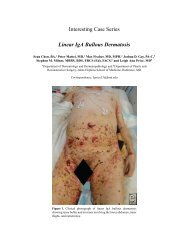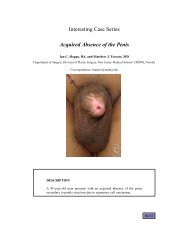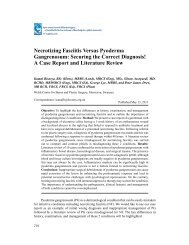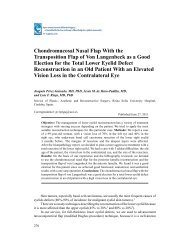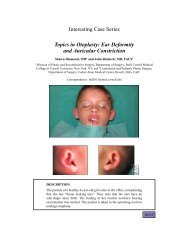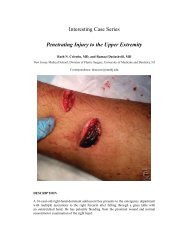Anatomical Landmarks for Safe Elevation of the Deep ... - ePlasty
Anatomical Landmarks for Safe Elevation of the Deep ... - ePlasty
Anatomical Landmarks for Safe Elevation of the Deep ... - ePlasty
Create successful ePaper yourself
Turn your PDF publications into a flip-book with our unique Google optimized e-Paper software.
CHOWDHRY ET ALdemonstrated fewer abdominal wall complications such as hernias, bulges, weakness, andshorter hospital stay. 5These ef<strong>for</strong>ts have culminated in identifying and employing <strong>the</strong> deep inferior epigastricartery (DIEA) and its per<strong>for</strong>ators as an ideal vascular pedicle <strong>for</strong> free flap reconstruction.As <strong>the</strong> branching pattern and location <strong>of</strong> <strong>the</strong> DIEA vary among patients, <strong>the</strong> reconstructivesurgeon is challenged to employ techniques to more effectively identify appropriate vessels<strong>for</strong> flap basis.Understanding per<strong>for</strong>ator characteristics is necessary to determine an ideal vessel <strong>for</strong>flap basis. Moon and Taylor describe major branching patterns as type I (single trunk), type II(bifurcation), and type III (trifurcation), with types I and II being <strong>the</strong> most common. 6 Caliberand course are also important components <strong>of</strong> vessel characteristics. The DIEA coursesbetween <strong>the</strong> anterior rectus sheath and <strong>the</strong> rectus muscle and will usually travel through <strong>the</strong>rectus muscle <strong>for</strong> part <strong>of</strong> its course. Medial and lateral branches have been associated withtype II and III patterns. 7 The lateral branch is in close proximity to <strong>the</strong> motor nerves to <strong>the</strong>rectus muscle. Extensive dissection <strong>of</strong> <strong>the</strong>se lateral branches can denervate <strong>the</strong> rectus muscleand defeat <strong>the</strong> purpose <strong>of</strong> this muscle-sparing flap. Similarly, per<strong>for</strong>ators with significantintramuscular components can lead to extensive muscle dissection and increased abdominalwall morbidity. 4,8,9 Optimal per<strong>for</strong>ator identification is essential as evidence suggests thatbasing <strong>the</strong> flap on a single large caliber (>1 mm) per<strong>for</strong>ator with minimal intramuscularcourse results in decreased tissue loss and abdominal wall complications.Several perioperative techniques to facilitate ease <strong>of</strong> identification <strong>of</strong> <strong>the</strong>se vesselsinclude Doppler ultrasonography, computed tomographic angiography, and magnetic resonanceangiography. 10 However, selection <strong>of</strong> <strong>the</strong> per<strong>for</strong>ator is possible only through operativeabdominal wall dissection. While anatomic and radiographic studies have shown <strong>the</strong> courseand nature <strong>of</strong> <strong>the</strong> DIEA, none have demonstrated <strong>the</strong> use <strong>of</strong> ratio landmarks to predict <strong>the</strong>location <strong>of</strong> <strong>the</strong> DIEA and its per<strong>for</strong>ators. We report our measurement <strong>of</strong> superficial landmarksto identify where <strong>the</strong> DIEA enters <strong>the</strong> rectus abdominis muscle along a longitudinalaxis, <strong>the</strong> location <strong>of</strong> first DIEA per<strong>for</strong>ator, and <strong>the</strong> application <strong>of</strong> <strong>the</strong>se measurements toharvesting <strong>the</strong> deep inferior epigastric per<strong>for</strong>ator (DIEP) flap.METHODSTen fresh cadaveric hemi-abdomens were dissected with <strong>the</strong> aid <strong>of</strong> loupe magnification.In this study, <strong>the</strong>re were 4 male and 6 female specimens. Initial measurements were takenfrom <strong>the</strong> umbilicus to <strong>the</strong> xiphoid and <strong>the</strong> pubic symphysis. Through a midline abdominalapproach, adipocutaneous flaps were elevated beyond <strong>the</strong> lateral border <strong>of</strong> <strong>the</strong> rectus muscle.The anterior rectus fascia was <strong>the</strong>n incised along <strong>the</strong> lateral edge <strong>of</strong> <strong>the</strong> rectus muscle, and <strong>the</strong>DIEA was identified as it entered <strong>the</strong> lateral edge <strong>of</strong> <strong>the</strong> rectus muscle (Fig 1). Measurementswere taken from <strong>the</strong> vertical height <strong>of</strong> this junction, <strong>the</strong> DIEA-RAM-junction (DRJ), to<strong>the</strong> umbilicus. Dissection proceeded with <strong>the</strong> elevation <strong>of</strong> <strong>the</strong> rectus muscle, <strong>the</strong> DIEA,and its per<strong>for</strong>ators along <strong>the</strong> posterior aspect <strong>of</strong> <strong>the</strong> muscle (Fig 2). The first per<strong>for</strong>ator <strong>of</strong><strong>the</strong> DIEA was identified at <strong>the</strong> anterior rectus fascia layer and dissected down to its DIEAorigin (Fig 3). Again, measurements were taken from <strong>the</strong> vertical height <strong>of</strong> <strong>the</strong> per<strong>for</strong>atorto <strong>the</strong> umbilicus. In addition, transverse measurements were taken from <strong>the</strong> umbilicus to<strong>the</strong> lateral edge <strong>of</strong> <strong>the</strong> rectus and to <strong>the</strong> DIEA.337
<strong>ePlasty</strong> VOLUME 10Figure 1. A dissection <strong>of</strong> <strong>the</strong> rectus muscle, <strong>the</strong> deep inferior epigastric artery (DIEA)rectus junction (DRJ), and <strong>the</strong> DIEA. Note <strong>the</strong> location <strong>of</strong> where <strong>the</strong> DIEA enters <strong>the</strong>rectus muscle.RESULTSThe average distance from <strong>the</strong> xiphoid to umbilicus was 18.2 ± 1.27 cm. The distancefrom <strong>the</strong> umbilicus to pubis was 14.9 ± 2.3 cm. The vertical distance from <strong>the</strong> umbilicusto <strong>the</strong> DRJ was 10.45 ± 1.58 cm, and <strong>the</strong> vertical distance from <strong>the</strong> level <strong>of</strong> <strong>the</strong>umbilicus to where <strong>the</strong> first DIEA per<strong>for</strong>ator traverses <strong>the</strong> RAM was 7.4 ± 1.64 cm(Table 1).338
CHOWDHRY ET ALFigure 2. A dissection <strong>of</strong> <strong>the</strong> posterior aspect <strong>of</strong> <strong>the</strong> rectus muscle and <strong>the</strong>DIEA and its branching pattern.Table 1. <strong>Anatomical</strong> measurements and ratios ∗Cadaver A, cm B, cm C, cm D, cm A/B C/B D/B D/C1 19.00 13.00 11.00 7.00 1.46 0.85 0.54 0.642 19.00 15.00 11.00 9.00 1.27 0.73 0.60 0.823 16.50 15.00 10.00 7.00 1.10 0.67 0.47 0.704 16.50 15.00 10.00 6.00 1.10 0.67 0.40 0.605 19.50 13.50 10.00 8.25 1.44 0.74 0.61 0.836 19.50 13.50 9.50 7.50 1.44 0.70 0.56 0.797 17.00 13.00 8.50 5.50 1.31 0.65 0.42 0.658 17.00 13.00 8.50 5.00 1.31 0.65 0.38 0.599 19.00 19.00 13.00 9.00 1.00 0.68 0.47 0.6910 19.00 19.00 13.00 10.00 1.00 0.68 0.53 0.77Mean 18.20 14.90 10.45 7.43 1.24 0.70 0.50 0.71SD 1.27 2.32 1.59 1.64 0.18 0.06 0.08 0.08∗ A indicates xiphoid—umbilicus; B, umbilicus—pubis; C, umbilicus—DIEA; D, umbilicus—first per<strong>for</strong>ator.Distance ratios were <strong>the</strong>n calculated <strong>for</strong> <strong>the</strong> DIEA and its first per<strong>for</strong>ator. The distancebetween <strong>the</strong> umbilicus and <strong>the</strong> DRJ corresponds to approximately 0.7 times <strong>the</strong> distancebetween <strong>the</strong> umbilicus and <strong>the</strong> pubic symphysis. Similarly, <strong>the</strong> distance between <strong>the</strong> umbilicusand <strong>the</strong> first per<strong>for</strong>ator corresponds to approximately 0.5 times <strong>the</strong> distance between <strong>the</strong>umbilicus and <strong>the</strong> pubic symphysis (Table 1). Additional analysis demonstrated consistentfindings with regard to distance ratios <strong>for</strong> each specimen individually.DISCUSSIONThe reconstructive surgeon is constantly challenged to investigate and develop techniques toimprove functional and aes<strong>the</strong>tic outcome. Utilizing <strong>the</strong> DIEP flap <strong>for</strong> breast reconstructionprovides appropriate aes<strong>the</strong>tic outcome while preserving abdominal wall function. 11 339
<strong>ePlasty</strong> VOLUME 10Figure 3. A dissection with <strong>the</strong> per<strong>for</strong>ators marked.The burden to <strong>the</strong> surgeon typically lies in planning out <strong>the</strong> flap harvest and elevating<strong>the</strong> flap with its pedicle. Bony landmarks <strong>of</strong> <strong>the</strong> xiphoid and pubis are easily identified. Themidline and lateral edges <strong>of</strong> <strong>the</strong> rectus muscle and umbilicus can usually be palpated andinspected. We used <strong>the</strong>se bony and s<strong>of</strong>t tissue landmarks in conjunction with our findings340
CHOWDHRY ET ALto develop normalizing ratios to best determine where <strong>the</strong> DIEA crosses <strong>the</strong> rectus muscleand where <strong>the</strong> first per<strong>for</strong>ator penetrates through <strong>the</strong> anterior surface <strong>of</strong> <strong>the</strong> rectus.Variance in patient size can be corrected by using vertical distance ratios. For example,we noticed that female specimens had relatively shorter abdomens as represented by anaverage vertical height <strong>of</strong> 31.5 cm from <strong>the</strong> xiphoid to <strong>the</strong> pubis. On <strong>the</strong> o<strong>the</strong>r hand, malespecimens have an average vertical height <strong>of</strong> 34.2 cm. Despite variations in patients’ height,<strong>the</strong> individual distance ratios calculated <strong>for</strong> each specimen group were consistent with ouroverall distance ratios.After measuring <strong>the</strong> umbilicus to pubis distance, <strong>the</strong> surgeon can utilize <strong>the</strong>se ratiosto predict <strong>the</strong> location <strong>of</strong> <strong>the</strong> DIEA and its first per<strong>for</strong>ator. The DIEA crosses <strong>the</strong> rectusat approximately two thirds <strong>of</strong> <strong>the</strong> distance between <strong>the</strong> umbilicus and pubis and <strong>the</strong> firstper<strong>for</strong>ator can reliably be located at one half <strong>of</strong> this distance (Fig 4).These distance ratios can also be used <strong>for</strong> harvesting a rectus muscle flap, a pedicledTRAM, or free TRAM flap. Traditionally, a fascial incision and extensive dissection along<strong>the</strong> lateral border <strong>of</strong> <strong>the</strong> muscle may be necessary to determine <strong>the</strong> location <strong>of</strong> <strong>the</strong> DIEA as itcourses below <strong>the</strong> rectus muscle. The distance ratios described in this study can significantlyenhance our ability to dissect and divide <strong>the</strong> flap inferiorly while avoiding injury to <strong>the</strong>DIEA system.Figure 4. A schematic demonstrating <strong>the</strong> location <strong>of</strong> <strong>the</strong> deepinferior epigastric artery (DIEA), DIEA rectus junction (DRJ),and first per<strong>for</strong>ator. Note <strong>the</strong> average distance from <strong>the</strong> umbilicusto <strong>the</strong> level <strong>of</strong> <strong>the</strong> first per<strong>for</strong>ator and DRJ.341
<strong>ePlasty</strong> VOLUME 10CONCLUSIONKnowledge <strong>of</strong> anatomical landmarks can aid <strong>the</strong> surgeon in more efficiently harvesting<strong>the</strong> DIEP flap. We found that using longitudinal measurements between <strong>the</strong> umbilicusand <strong>the</strong> pubic symphysis along <strong>the</strong> abdominal midline can aid clinicians in predicting <strong>the</strong>location <strong>of</strong> <strong>the</strong> DIEA and its first per<strong>for</strong>ator. These measurements are coupled with distanceratios to correct <strong>for</strong> variance in patient size. We anticipate that this study will decrease <strong>the</strong>need <strong>for</strong> extensive intramuscular dissection, associated morbidities <strong>of</strong> hernia, bulge, anddenervation.REFERENCES1. Rozen W-M, Ashton M-W, Pan WR, Taylor GI. Raising per<strong>for</strong>ator flaps <strong>for</strong> breast reconstruction: <strong>the</strong>intramuscular anatomy <strong>of</strong> <strong>the</strong> DIEA. Plast Reconstr Surg. 2007;120:1443-9.2. Nano M-T, Gill P-G, Kollias J, Bochner MA, Carter N, Winefield HR. Qualitative assessment <strong>of</strong> breastreconstruction in a specialist breast unit. Aust N Z J Surg. 2005;75:445-3.3. Allen R-J. DIEP versus TRAM <strong>for</strong> breast reconstruction. Plast Reconstr Surg. 2003;111:466-75.4. Chen M-C, Halvorson E-G, Disa JJ, et al. Immediate postoperative complications in DIEP versusfree/muscle-sparing TRAM flaps. Plast Reconstr Surg. 2007;120:1477-82.5. Kroll S-S, Sharma S, Koutz C, et al. Postoperative morphine requirements <strong>of</strong> free TRAM and DIEP flaps.Plast Reconstr Surg. 2001;107:338-41.6. Moon H-K, Taylor G-I. The vascular anatomy <strong>of</strong> rectus abdominis musculocutaneous flaps based on <strong>the</strong>deep superior epigastric system. Plast Reconstr Surg. 1988;82:815-32.7. Rozen W-M, Palmer K-P, Suami H, et al. The DIEA branching pattern and its relationship to <strong>the</strong> per<strong>for</strong>ators:<strong>the</strong> importance <strong>of</strong> preoperative computed tomographic angiography <strong>for</strong> DIEA per<strong>for</strong>ator flaps. PlastReconstr Surg. 2008;121:367-73.8. Blondeel N, Vanderstraeten G-G, Monstrey SJ, et al. The donor site morbidity <strong>of</strong> free DIEP flaps and freeTRAM flaps <strong>for</strong> breast reconstruction. Br J Plast Surg. 1997;50:322-30.9. Futter C-M, Webster M-H, Monstrey SJ, et al. A retrospective comparison <strong>of</strong> <strong>the</strong> abdominal muscle strengthfollowing breast reconstruction with a free TRAM or DIEP flap. Br J Plast Surg. 2000;53:578-83.10. Rozen W-M, Stella D-L, Bowden J, Taylor GI, Ashton MW. Advances in <strong>the</strong> pre-operative planning <strong>of</strong> deepinferior epigastric artery per<strong>for</strong>ator flaps: magnetic resonance angiography. Microsurgery 2008;29:119-23.11. Nahbedian M-Y, Momen B, Galdino G, Manson PN. Breast reconstruction with <strong>the</strong> free TRAM or DIEPflap: patient selection. Plast Reconstr Surg. 2002;110:466-75.342



